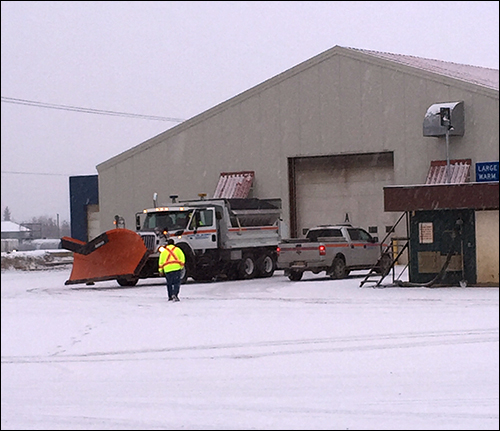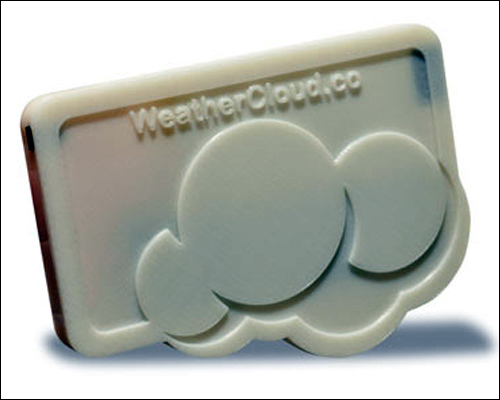It may only be late October, but winter arrived in Fairbanks, Alaska, weeks ago. And with its arrival, the city’s fleet of snowplows hit the streets. The snow and ice will remain until spring, says Daniel Schacher, the Fairbanks district superintendent of the Alaska Department of Transportation and Public Facilities (AKDoT&PF). Dealing with slick roads is nothing new to residents of that city, which sits at a latitude of 65 degrees north, but Schacher says that in recent years, changes to the winter weather have made maintaining safe roads more difficult.
“In 2010, we had a huge ice storm,” Schacher states. “The temperature went from 35 degrees [Fahrenheit] below zero, to 50 degrees above zero, and it rained for three days straight before temperature fell back below zero. As a result, we had two inches of shiny ice for the rest of the winter.”
This was not a one-time event. “We’ve had measurable freezing rain every winter for the past six years,” Schacher says. Plus, climate models forecasting rising global temperatures and increased temperature variability indicate that icy roads will be a long-term occurrence. “This appears to be the new normal.”
To help adjust to highly variable road conditions and keep motorists safe, Schacher and the Fairbanks DoT district have, in recent years, been relying increasingly on sensor technology to better understand road conditions in real- or near-real-time. For the past four winters, the DoT has used the Road Weather Information System (RWIS), a statewide network of roadside telemetry stations that track both surface and subsurface temperatures, as well as the air temperature, dew point temperature, relative humidity, wind speed and direction, precipitation occurrence, precipitation accumulation, atmospheric station pressure, snow depth and stream water level. The stations also include cameras that capture periodic images.
This data is transmitted, via a cellular network, to a cloud-based database, called the Maintenance Decision Support System (MDSS), which each DoT station foreman uses to determine what kind of treatment—such as applying sodium chloride, plowing or some other action—his or her crew’s trucks will use in an effort to keep roads well maintained. The MDSS also incorporates atmospheric weather and forecast data supplied by the National Oceanic and Atmospheric Administration.
There are eight roadside RWIS stations in and around Fairbanks, but they provide data regarding a relatively small slice of the city’s roadways. “We needed mobile weather observations to fill in gaps,” Schacher says. Those gaps are significant because Fairbanks sits in a valley, so the hillsides just outside town can have very different weather than roads in the city center. A few years ago, Schacher began investigating the use of on-vehicle sensors that could provide the same types of data as the RWIS stations.
The department initially engaged with an on-vehicle sensor provider (which Schacher declines to name), whose technology was prohibitively expensive and generated data that was difficult to integrate with the MDSS. Then, while attending a conference, Schacher meet a representative from a startup called WeatherCloud. For the past two winters, AKDoT&PF vehicles in Fairbanks have been outfitted with WeatherCloud’s sensor modules, which collect and share data on road conditions and weather, and then transmit that information, via a Bluetooth connection, to an app running on the driver’s Android phone. If the vehicle is within cellular range, the data is immediately uploaded to WeatherCloud’s cloud-based server, where the agency accesses it. If the vehicle is beyond range, the data is stored on the phone and then uploaded as soon as the vehicle comes into range.
“WeatherCloud specializes in ground-truth weather, which is the stuff that satellite data can’t give you,” says Christy Szoke, the co-founder and CMO of Fathym, a Colorado-based software company that acquired WeatherCloud in 2015. “Road weather can be affected by microclimates and even by cars driving on the road,” she explains, which means that just a short distance from a stationary weather station, such as an RWIS station, the road conditions can change significantly. (A microclimate is a small geographic area in which weather tends to be different than the larger region, due to topography, proximity to a large water source, or some other landscape feature. Alaska hosts a number of microclimates—due, in part, to its steep mountain ranges and extensive coastline.)
Twenty vehicles used in the Fairbanks AKDoT&PF fleet have been outfitted with WeatherCloud’s two sensor modules, the Roadpack and the Skypack. The agency started installing them in 2014. The Roadpack, mounted above the vehicle’s license plate, contains an infrared thermometer, a microphone, a microcontroller and a Bluetooth Low Energy (BLE) radio. The device measures dew point, ambient temperature, pavement temperature and road conditions, such as wet, icy or snow-packed, and can be programmed to determine crosswinds.
The Skypack, mounted on the inside of the windshield, contains a precipitation sensor, an ambient light sensor, a microcontroller and a BLE radio. By measuring capacitance on the windshield, the precipitation sensor determines if rain or snow is falling, as well as whether the windshield wipers are in motion. The Skypack also includes an inertial measurement unit (IMU), which tracks the vehicle’s movement and pitch, and is used to improve the accuracy of tracking data when paired with GPS data in the Android-based application running on the smartphone. The IMU “also describes things that aren’t associated with position, like which angle the vehicle is at or if the vehicle is slipping versus having good traction,” says John Mickey, WeatherCloud’s director of hardware engineering. Both the Roadpack and the Skypack, Schacher notes, are wired into the host vehicle’s power system.
Now, data collected from the regional RWIS stations and the WeatherCloud platform is collected by the MDSS, providing Schacher and his crew with a much more granular understanding of road conditions throughout Fairbanks and the surrounding region. The agency uses MDSS all year-round. When snow and ice are not factors, it utilizes the system to schedule and manage roadwork.
A grant of approximately$400,000 from the Federal Highway Administration has covered the costs of purchasing and evaluating the initial sensor technology and the WeatherCloud system in Fairbanks. Thanks to another similar-sized grant, another 40 vehicles in southern Alaska, on the Kenai Peninsula, are being outfitted with the WeatherCloud sensors as well.
Going forward, the Alaska Department of Transportation and Public Facilities will need its state legislature to approve a line-item in the agency’s budget to pay for the technology’s upkeep and expansion across the state. To make its case, the agency will need to show that the solution will generate a return on investment by making the roads safer.
“Improving highway safety is our primary goal,” says Ocie Adams, an AKDoT&PF project manager. “So, in the long term, we also look at the crash data for three years before deployment and three years after deployment to see if we have improved highway safety.”
That said, Adams notes, crash data is not fully vetted and available for two years following an accident. As such, the agency will not be able to process crash data for the three-year period following the deployment of the RWIS system until next year, and it will be two more years before it will be able to determine what impact WeatherCloud has had.
In the meantime, the AKDoT&PF will continue using data from both the RWIS system and WeatherCloud sensors to inform its road-treatment decisions. It is not the only Department of Transportation to begin using WeatherCloud, Szoke reports, as counterpart agencies in Colorado, Iowa and Utah are also beginning to use the system.



